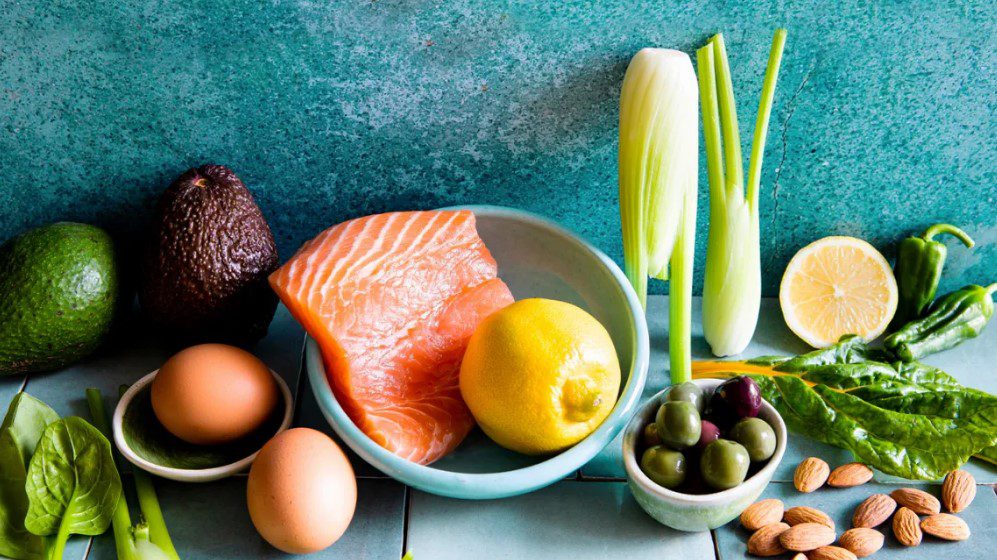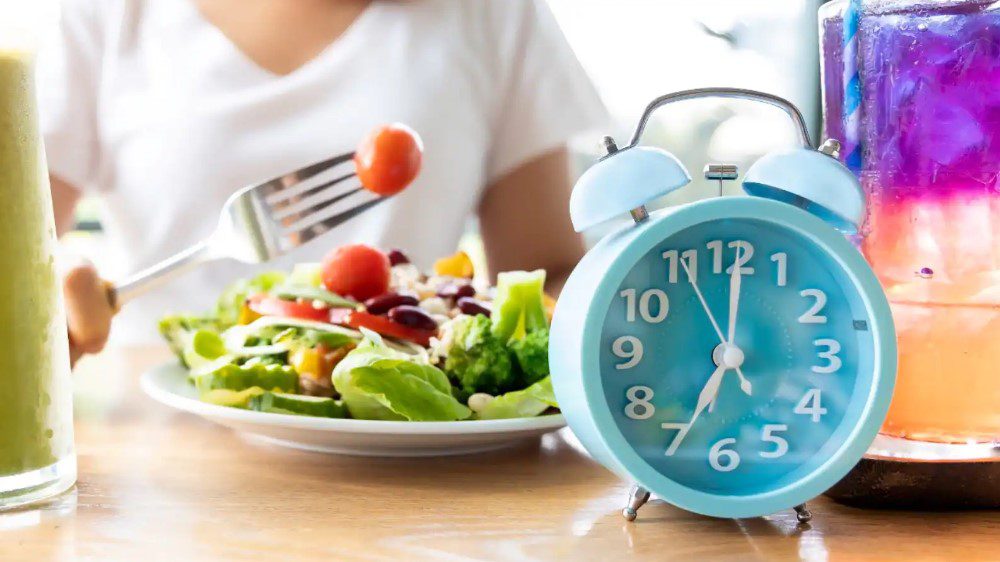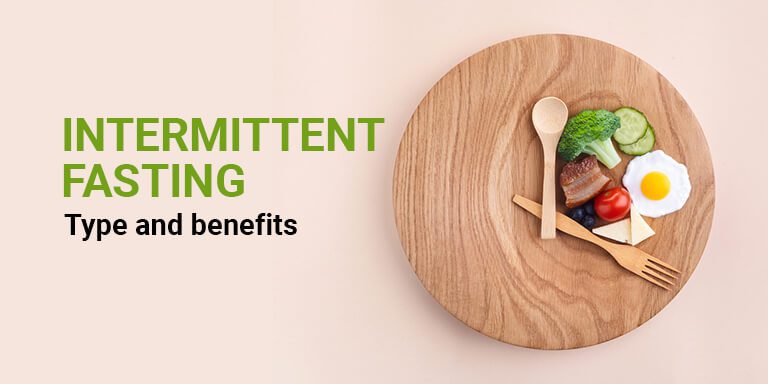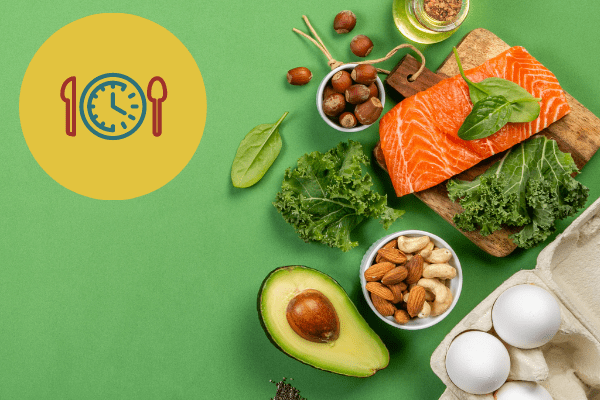Discover how to get the most out of a ketogenic diet by following our step-by-by-step guide to keto intermittent fasting meals. Lose weight and improve your health at the same time!
Intermittent fasting (IF) and the ketogenic diet (KD) increase the speed at which your body enters ketosis. If you want to lose weight quickly, you should follow an intermittent fasting keto diet. During ketosis, your body will burn fat for energy instead of carbohydrates, allowing you to lose weight by using fat as a source of energy.
If you’d like to lose weight quickly and burn more fat than ever before, learn how to combine keto and fasting. To help you get started, we’ve put together a 19-day keto intermittent fasting meal plan and guide.
THE KETOGENIC DIET
To begin, let’s talk about the ketogenic diet, or “The Keto Diet.”
A keto diet meal plan can improve a wide range of health issues while also allowing you to lose weight. People are starting to realize that this is not a fad diet, and I am here to explain why. The Keto and intermittent fasting diets are the Atkins and 5/2 of our time, respectively.
It’s safe to say that the extreme popularity of these two diets has influenced our eating habits today, both positively and negatively. Their combined reach and cult status in some areas of the health and fitness industry make them impossible to ignore. Health problems such as type 2 diabetes, dementia, heart disease, as well as cancer growth have been shown to be improved and slowed by following a ketogenic diet meal plan.
However, how do they all fit together in the end? What can we expect from combining the keto diet with intermittent fasting (IF)?
Today, we’re going to answer all of your questions about 21st-century diets, as well as how these two renowned diets work together.
To get the most out of your Keto Diet and incorporate intermittent fasting, improve your athletic performance, and follow the scientific approach to dieting – without marketing spin!
WHAT IS THE KETO DIET?

In an article about diets, fasting, and weight loss, you may be wondering what bacon has to do with it and why it’s being mentioned. You can think of the ketogenic diet as a very low-carb, high fat diet that causes your body to produce more ketones in the liver. These ketones are what the body burns to produce energy.
You’ve probably heard of the Keto Diet or one of its many other names, such as the low-carb, low-carb high-fat, or simply the LCHF acronym for low-carb high-fat. Before diving into the specifics of the Keto Diet, it’s critical to understand that the primary source of weight gain for the majority of people is the consumption of carbohydrates. Carbs aren’t good for you!
Any high-carbohydrate food immediately triggers a response in your body, resulting in the production of glucose and insulin. It’s widely accepted that glucose is the body’s primary source of energy, but this doesn’t necessarily imply that it’s the most efficient. Insulin is secreted into your body in order to help your body process and distribute the glucose in your bloodstream. This means that when your body uses glucose as its primary source of energy, your fats are not required.
Where do all of these fats go?
I wish they’d just vanish into thin air because they’re so pointless, but that isn’t the case. Instead, the fat is dispersed throughout your body, which is the root cause of your accumulating fat and weight. If you follow the typical American diet of lots of carbs, your body will use glucose as its primary energy source.
Refined carbohydrate-based diets account for a large portion of the average American’s diet. In the US, 39.6 percent of adults over the age of 20 are considered clinically obese because the average American man consumes 296 grams of carbs per day and the average American woman consumes 224 grams per day.
When you cut back on carbs, your body goes into a fat-burning state known as ketosis, but what exactly does this mean?
In a nutshell, ketosis is a natural bodily process that your body initiates when your food intake drops below normal. As your liver breaks down fats, your body produces ketones, which your body uses as fuel. The ultimate goal of a well-maintained ketogenic diet is to put your body into a metabolic state known as ketosis. As a result, you’re essentially achieving ketosis through starvation of carbohydrates rather than calories.
When it comes to your body’s ability to adapt to what you feed it, you have to give it some credit. When carbohydrates are removed from the diet and more fat is consumed, the body shifts to using ketones as its primary source of energy rather than glucose.
Your body’s optimal ketone levels will allow you to reap a wide range of health benefits, including fat loss and other physical and mental performance advantages.
WHAT IS INTERMITTENT FASTING?

Fasting, in contrast to other forms of dieting, is simple and clear. For as long as we can remember, we’ve all done it unconsciously when we skip breakfast or dinner because we’re too rushed or too busy.
Our caveman ancestors would often be in a state of fasting while they hunted for their next meal, making it clear that this way of life has been practiced for thousands of years. Before agriculture and civilization, there was the hunter-gatherer period. Although there were times when food was scarce or the seasons suddenly changed, fasting was still prevalent.
Everyone, from the aristocracy to the peasants, prepared for the harsh winters by stockpiling grains and cured meats. There was a famine as a result of the lack of irrigation systems, and people were forced to fast in order to extend the shelf life of their stored goods.
Many religions included a period of fasting as a way to show their devotion to the God or Gods they regarded as most important. Consider the Hindu practice of strict fasting during special festivals as an example of this penance or worship of the deities, known as “Vaasa” by the Hindus. For the month of Ramadan, Muslims refrain from eating and drinking between certain hours of the day. The six weeks leading up to Easter during Lent are a time for fasting in Catholicism.
Intermittent fasting is often misunderstood as a diet, but this is not the case. It’s more accurately described as a pattern of dieting or a deliberate decision to skip meals. In the case of intermittent fasting, you usually consume all of your caloric intakes during a specific time period.
A variety of intermittent fasting methods exist, and it’s important to experiment to find the one that works best for you, just like dieting!
TYPES OF INTERMITTENT FASTING

- THE 16/8 PROTOCOLIt’s all in the numbers, really.It’s a 16-hour fast, followed by an 8-hour window in which you consume your daily calories. In order to maintain a fasting state while you sleep, most people choose simple eating hours like noon to 8 p.m., which means they skip breakfast, which isn’t all that difficult since most people these days eat breakfast on the go.In some cases, those who are a little more strict about their fasting may choose to eat only once every six or four hours, for example.
-
THE 5:2 DIET (THE FAST DIET)
This type of fasting entails eating normally for five out of the seven days of the week in a row. On the final two days, you must drastically reduce your caloric intake to around 500 calories for women and 600 calories for men.
-
THE 24-HOUR PROTOCOL
The 24-hour protocol entails skipping two meals a day and then not eating again for a period of twenty-four hours. You wouldn’t have another meal until 7.30 PM the next day if you ate a normal dinner schedule and finished it at 7.30 PM.
When it comes to your three daily meals, you would eat your usual three each day, and then choose one day a week to skip both breakfast and lunch. If you can’t last for a full 24 hours, that’s fine; start with an 18-hour fast and gradually work your way up to the full 24 hours. It’s entirely up to you how often you do this per week.
That’s why it’s so great! You choose the days that work best for you and your current situation.
-
ALTERNATE DAY FASTING
Every alternate day, you must abstain from food for that period of time. This means that you can either completely abstain from food on fast days or severely restrict your calorie intake to around 500.
If you’re just starting out, I’d suggest cutting your daily caloric intake and working your way up to an every-other-day full-day fast. If you’ve hit a weight-loss stalemate, this is a great way to re-start the fat-burning process.
-
THE WARRIOR DIET – DAY FASTING
An all-day fast is followed by an all-night splurge within a four-hour window at night.
Celebrity fitness coach Ori Hofmekler is credited with popularizing this type of diet, which emphasizes the consumption of unprocessed foods. Since the Warrior Diet is a ketogenic diet, you’ll have to be a little more strict and cut out any processed food, which unfortunately includes bacon.
WHY INTERMITTENT FASTING? WHAT’S THE FUSS?
It’s one of my go-to responses to the question “Why do you fast?” is “Because it works for your goals!” the answer to the question, “Are you religious?”
It’s a no-brainer that caloric restriction is essential to losing weight. When you fast, this caloric restriction becomes a piece of cake, especially if you use your sleeping time as a time to fast. Weight loss can be maintained if done correctly by a healthy individual. In addition to the numerous benefits of intermittent fasting, here are a few more.
BENEFITS OF INTERMITTENT FASTING
Our lives are a whirlwind. Is there really anyone out there who has the time to prepare X number of meals to eat every three hours? I salute you if you’re one of these people.
When you’re fasting, you only have to worry about what you’ll eat during your meal period. As we all know, life gets in the way, and deciding what to eat in a shorter amount of time is one less decision you’ll have to make on a daily basis is a big relief. You’ll be able to sit back and savor larger portions of food if you eat fewer meals at a window instead of birdfeed-style ones all day. Having consumed an adequate amount of food, you will no longer be concerned about becoming hungry.
What’s more?
Still, you’ll have consumed fewer calories than usual. In the end, IF doesn’t require a lot of preparation time. It’s also likely to save you money. To save time and money, you only need to buy and prepare two meals per day. You won’t have to interrupt your work six times a day; instead, you’ll only have to stop twice.
And if you’re like me, who despises all forms of housework, you’ll only have to wash the dishes twice a day. It’s no secret that IF is more convenient and less expensive.
Health benefits can’t be overlooked when it comes to intermittent fasting (IF). Growth hormone secretion and insulin sensitivity are both aided by this supplement, which is critical for muscle gain and fat loss.
So how about combining an IF diet with a ketogenic one?
IF can help you lose weight as well as improve the health of your brain.
I’m more alert and focused than I was before, which is something I’ve always struggled with when trying out different eating regimens. This was largely due to the fact that I was constantly hungry and trying to ignore the sounds of my stomach grumbling.
IF, like a ketogenic diet, can help alleviate the symptoms of Alzheimer’s, dementia, and Parkinson’s disease, as well as improve focus.
INTERMITTENT FASTING AND KETO

This means that your body is forced into a mode of operation that uses fat as fuel rather than carbohydrates. Your body will use ketones as its primary fuel if you restrict your intake of carbohydrates and glucose, a process is known as ‘ketosis,’ which can occur in two ways.
As a first step, you can eat foods low in carbs and high in natural healthy fats in order to induce ketosis (i.e., a ketogenic diet). So it is safe to assume that when you combine the two, it is a formidable weight loss combination.
It is common to hear the term “fast period” used to describe the period during which you are not eating or drinking. In the absence of glucose, your liver begins breaking down fat into ketones, which is why fasting can cause ketosis to occur on its own. Many experts in the keto diet community recommend fasting for a short period of time (24-36 hours) before beginning a keto diet, as it can help your body transition into ketosis more quickly and effectively.
Intermittent fasting while in ketosis can help keep your body in that state.
For a variety of reasons, including the fact that following a strict keto diet can be difficult, to begin with, there’s a small chance that you’ll eat something that isn’t keto-friendly, and as a result, you’ll be knocked out of ketosis.
Ketogenic diet newbies are prone to overeating for two reasons: first, because the food is so darn delicious, and second because many people who begin the diet have previously had trouble with issues like portion control, so we have one less chance of messing it all up.
It’s not a one-size-fits-all approach to nutrition. It’s up to you to decide what works and what doesn’t work for you.
Because your body still has stored glucose from your carb-filled meals, skipping breakfast alone is unlikely to help you become keto-adapted (when your body runs on ketones). You’ll need to fast for a longer period of time to deplete your glucose stores if you want to use fasting to achieve ketosis. You’ll have to combine intermittent fasting with a low-carb ketogenic diet to get your body into ketosis faster with intermittent fasting.
The moral of the story is that you should experiment with various methods of entering ketosis in order to discover which one works best for you and which one best fits your lifestyle.
DIET AND MEAL PLAN BREAKDOWN
During the first five days of our Keto Diet, we’ll be putting our bodies through the rigors of a strict ketosis-inducing regime. Stage 2 of the diet (days 6-19) is when we ease up on the restrictions and begin to reap the rewards!
THE FIRST 5 DAYS OF KETO
In the first five days of the Keto diet, there are a few possible side effects. These are to be expected on any diet and will subside within a few days. Whether or not the diet is intended for children or adults will also make a difference.
If you understand why these side effects occur, you’ll be able to control them. You will be less likely to quit if you know what to expect and how to deal with it. In just a few hours, your body will be burning fat instead of glucose for energy, putting an end to the uncomfortable side effects.
Before beginning any exercise program, you should consult with your doctor. Take care of yourself for the sake of your safety and long-term well-being.
-
LOW BLOOD SUGAR (HYPOGLYCEMIA)
When you eat a lot of carbs, your body produces insulin to counteract the sugar that is produced. Low blood sugar episodes may occur as your carb intake decreases on the Keto diet.
Confusion, dizziness, and nausea are common signs. Weakness and anxiety are common symptoms of a variety of illnesses and medical conditions.
If you’ve never been through it before, it can be intimidating. It’s the simplest way to keep this from happening, so if you feel like this is about to happen, just take one or two glucose tablets.
-
HEADACHES
It’s possible to get headaches for no apparent reason when making a major change to your diet.
You may feel dizzy and have flu-like symptoms for a few days at a time. These headaches are caused by a lack of minerals in the diet.
Drinking a glass of water flavored with 1/4 teaspoon of salt will solve this problem quickly. The effects will be felt after 15 to 20 minutes of sitting still.
For the first few days, make sure you’re getting enough water and salt in your diet to avoid dehydration. This can effectively prevent headaches from occurring.
-
FATIGUE AND DIZZINESS
You will lose many minerals during the first week of the diet because your body will begin to lose its stored water content. You may experience tiredness, dizziness, and lightheadedness, as well as the risk of muscle cramps and itchy skin.
Increase your intake of leafy green vegetables to help counteract these side effects. Alternatively, multivitamin tablets containing the RDAs for the missing minerals can be used as a fallback. As previously mentioned, avoid high-carbohydrate vegetables.
-
CONSTIPATION
Another common side effect is constipation. This is caused by dehydration, salt loss, magnesium deficiency, or excessive consumption of dairy and nut products. If taking magnesium-boosting vitamin tablets doesn’t help, you may have to cut back on dairy intake even further.
-
DIARRHEA
Fortunately, these symptoms typically only last a few days. Your body should adjust to the increased fat content and these symptoms should go away once you’ve done so. To avoid becoming dehydrated, make sure you’re drinking plenty of fluids to replenish what you’ve lost.
-
INTERRUPTED SLEEP PATTERNS
If you’re having trouble sleeping while on the Keto diet, it may be an indication that your insulin levels are too low. Take a small snack with equal amounts of protein and carbohydrates just before going to bed to solve this problem. As a result, your insulin levels will be more stable for the duration of the night.
-
HEART PALPITATIONS
A strong cup of coffee may cause this for some people while not for others. A person’s low blood pressure may be a sign of low blood pressure while on the keto diet. Consult a doctor whenever in doubt.
-
You can’t seem to shake this effect, and it’s one of the most troublesome to deal with. If you give yourself some time, these symptoms will go away in a matter of days to a few weeks.
Doing some light exercise or finding something to keep your mind off of your cravings can help you overcome them. Sugar cravings only last an hour, so they’ll be gone by the time you finish your workout. You can also eat a small salad or a quick-to-prepare keto smoothie recipe as a snack, which both contain a small amount of protein.
While children are still growing, the risks of a ketogenic diet are too great. It’s better to provide them with a healthy diet rich in fruits, vegetables, whole grains, and proteins, and to limit their intake of added sugars like soda and other sweets.
STAGE 1: WEEK 1 (DAYS 1-5)
If you don’t like a particular meal, feel free to mix and match your favorites. Depending on how hungry you are and how many calories you should be consuming, you may want to include a couple of snacks each day.
Check out our keto calories guide to get an idea of how many calories you should be consuming each day if you’re trying to lose weight. You can figure out how many servings and calories are in each recipe, so you know exactly how much you should be eating each day.
Choose the fasting method that is most comfortable for you and divide your food accordingly.
When using 16/8 fastening, for instance (8:00 PM to 12:00 PM Fasted)
INTERMITTENT FASTING KETO SCHEDULE
- 6:00 AM – Wake up, coffee/tea with no sugar or milk.
- 12:00 PM – Meal 1
- 2:00 PM – Snack
- 4:00 PM – Meal 2
- 6:00 PM – Snack
- 8:00 PM – Meal 3
DAY 1
- Meal 1 – Cranberry Pancakes (1 serving)
- Snack – 4-Seed Crispy Crackers (6 servings)
- Meal 2 – Cauliflower Salad (1 serving)
- Snack – No-Bake Raspberry Cheesecake Bites (4 servings)
- Meal 3 – Philly Cheesesteak Casserole (1 serving) + Cacao Chia Pudding (1 serving)
- Summary – 1635 calories and 28.2 grams of net carbs
DAY 2
- Meal 1 – Leek and Bacon Omelette (1 serving)
- Snack – 4-Seed Crispy Crackers (4 servings)
- Meal 2 – Deviled Egg Salad (1 serving)
- Snack – No-Bake Raspberry Cheesecake Bites (2 servings)
- Meal 3 – Keto Pad Thai (1 serving)
- Summary – 1760 calories and 13.9 grams of net carbs
DAY 3
- Meal 1 – Pumpkin Pancakes (2 servings)
- Snack – Peanut Butter Mousse (1 serving)
- Meal 2 – BLT Salad with Avocado & Cheese (1 serving)
- Snack – Tortilla Chips (2 servings)
- Meal 3 – Shepherd’s Pie (1 serving)
- Summary – 1554 calories and 27.9 grams of net carbs
DAY 4
- Meal 1 – Keto Chaffles (2 servings) + Crispy Bacon (2 servings)
- Snack – Cheesecake Fat Bombs (3 servings)
- Meal 2 – Lahmacun (Turkish Pizza) (2 servings)
- Snack – Tortilla Chips (2 servings)
- Meal 3 – Chicken Meatballs with Zoodles (1 serving)
- Summary – 1760 calories and 27 grams of net carbs
DAY 5
- Meal 1 – Fathead Bagels (2 servings)
- Snack – Crispy Parmesan Crackers (2 servings)
- Meal 2 – Easy Salad with Italian Dressing (1 serving)
- Snack – Cheesecake Fat Bombs (3 servings)
- Meal 3 – Easy Zucchini Alfredo (1 serving)
- Summary – 1819 calories and 21.8 grams of net carbs
STAGE 2: WEEK 2 (DAYS 6-12)
Congratulations! You’ve completed the first five days of Stage 1.
For the next two weeks, you’ll notice that the macros are a little more evenly distributed. You can use the recipes exactly as written or make substitutions. Don’t make the ones you don’t like again.
DAY 6
- Meal 1 – Cranberry Pancakes (1 serving)
- Snack – Chocolate Mousse (1 serving)
- Meal 2 – Iceberg Wedge Salad (1 serving)
- Snack- Crispy Parmesan Crackers (2 servings)
- Meal 3 – One-Pan Garlic Butter Chicken (1 serving)
- Summary – 1729 calories and 22.5 grams of net carbs
DAY 7
- Meal 1 – Keto Egg Muffins (2 servings)
- Snack – Coconut Cookies (2 servings)
- Meal 2 – Cauliflower Pizza (2 servings)
- Meal 3 – Keto Meatloaf (3 servings) + Homemade Keto Ice Cream (1 serving)
- Summary – 1772 calories and 31.8 grams of net carbs
DAY 8
- Meal 1 – Almond Flour Banana Bread (2 servings)
- Snack – Cream Cheese Lemon Fat Bombs (3 servings)
- Meal 2 – Fish Cakes with Garlic Aioli (2 servings)
- Snack – Keto Avocado Smoothie (1 serving)
- Meal 3 – Almond Flour Pizza with Feta and Bacon (2 servings)
- Summary – 1812 calories and 21.2 grams of net carbs
DAY 9
- Meal 1 – Keto Chia Seed Pudding (1 serving)
- Snack – No-Bake Peanut Butter Energy Balls (2 servings)
- Meal 2 – Keto Lettuce Wraps (2 servings)
- Snack – Almond Flour Banana Bread (2 servings)
- Meal 3 – Roast Chicken with Broccoli & Garlic Cheese
- Summary – 1697 calories and 25.21 grams of net carbs
DAY 10
- Meal 1 – Easy Zucchini Bread (2 servings)
- Meal 2 – Tuna Cucumber Cups (2 servings)
- Snack – No-Bake Peanut Butter Energy Balls (2 servings)
- Meal 3 – Beef Stroganoff (1 serving) + Keto Gelato Bars (2 servings)
- Summary – 1573 calories and 30 grams of net carbs
DAY 11
- Meal 1 – Baked Avocado Egg Boats (2 servings)
- Snack – Keto Donut Holes (4 servings)
- Meal 2 – Creamy Pumpkin Soup (1 serving)
- Meal 3 – Easy Balsamic Chicken (1 serving) + Baked Zucchini Fries (1 serving)
- Summary – 1738 calories and 2.9 grams of net carbs
DAY 12
- Meal 1 – Healthy Pumpkin Bars (2 servings)
- Snack – Keto Donut Holes (4 servings)
- Meal 2 – Raspberry Cheesecake Smoothie (1 serving)
- Snack – Peanut Butter Cookies (3 servings)
- Meal 3 – Caprese Chicken (1 serving) + Baked Zucchini Fries (1 serving)
- Summary – 1830 calories and 30 grams of net carbs
STAGE 2: WEEK 3 (DAYS 13-19)
Now that you’ve gotten the hang of it, I’m sure you’ll see results soon if you’ve followed the diet to the letter. For now, we hope this keeps you going, as well as the recipes we have planned for you in week three.
DAY 13
- Meal 1 – Keto Crepes (1 serving)
- Snack – Peanut Butter Cookies (2 servings)
- Meal 2 – Vegetarian Cauliflower Sushi (2 servings)
- Snack – No-Bake Peanut Butter Energy Balls (2 servings)
- Meal 3 – Chinese Orange Beef (2 servings)
- Summary – 1803 calories and 25.8 grams of net carbs
DAY 14
- Meal 1 – Keto Egg Loaf (2 servings)
- Snack – Baked Zucchini Balls (4 servings)
- Meal 2 – Keto Peanut Butter Smoothie (1 serving)
- Meal 3 – Lemon Garlic Salmon (1 serving) + Pumpkin Mousse (1 serving)
- Summary – 1649 calories and 22 grams of net carbs
DAY 15
- Meal 1 – Keto Egg Muffins (2 servings)
- Snack – Avocado Brownies (2 servings)
- Meal 2 – Deviled Egg Salad (1 serving)
- Meal 3 – Eggplant Casserole (2 servings) + No-Bake Cheesecake (1 serving)
- Summary – 1596 calories and 25.9 grams of net carbs
DAY 16
- Meal 1 – Fathead Bagels (2 servings)
- Snack – Parmesan Croutons (1 serving)
- Meal 2 – Halloumi Salad (1 serving)
- Meal 3 – Pan-Seared Salmon with Goat Cheese (1 serving) + No-Bake Cheesecake (1 serving)
- Summary – 1845 calories and 20.5 grams of net carbs
DAY 17
- Meal 1 – Leek and Bacon Omelette (1 serving)
- Meal 2 – BLT Salad with Avocado & Cheese (1 serving)
- Meal 3 – Baked Chicken with Yogurt & Lime (1 serving) + Loaded Cauliflower Mash (1 serving)
- Summary – 1828 calories and 21.5 grams of net carbs
DAY 18
- Meal 1 – Keto Crepes (1 serving)
- Snack – Cream Cheese Lemon Fat Bombs (3 servings)
- Meal 2 – Bacon Egg & Cheese Sliders (2 servings)
- Meal 3 – Baked Salmon and Green Beans (1 serving) + Keto Chocolate Cake (2 servings)
- Summary – 1673 calories and 25.8 grams of net carbs
DAY 19
- Meal 1 – Keto Chaffles (2 servings) + Crispy Bacon (2 servings)
- Snack – Pumpkin Spice Chocolate Chip Cookies (3 servings)
- Meal 2 – Cauliflower Salad (1 serving)
- Snack – Fathead Cinnamon Rolls (1 serving)
- Meal 3 – Ground Beef Cauliflower Curry (1 serving)
- Summary – 1594 calories and 30 grams of net carbs
FINAL THOUGHTS
What you need is a keto diet and intermittent fasting (IF) to get your ass in gear. Instead of a diet, it’s a way of life, one that’s easy to maintain and one that can be sustained for the long term.
If you stick to an intermittent fasting ketogenic diet, you’ll be able to shed pounds. What’s even better is that it has additional health benefits like helping to regulate blood sugar levels and preventing certain cancers and Alzheimer’s from developing. As compared to other diets out there, this one isn’t nearly so restrictive. Because it has been around for a long time, unlike many of the other diet fads we’ve seen recently, you’ll soon discover.
It can also include an impressive variety of tasty and nutritious foods, which is great news for those of us trying to stay under our net carb limits.




